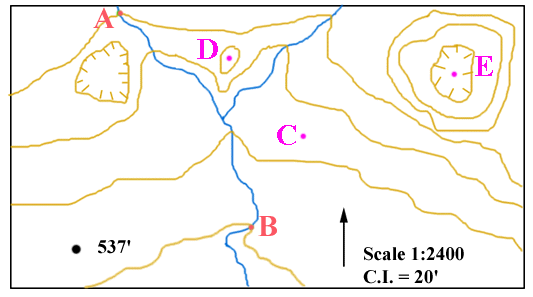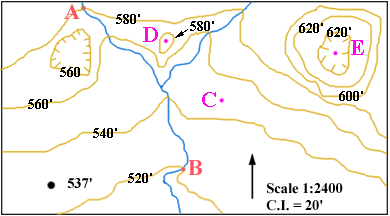WORKED-OUT CONTOUR MAP PROBLEM

WORKED-OUT CONTOUR MAP PROBLEM

THE PROBLEM ASKS ME DO THE FOLLOWING:
|
1. The map is shown to the right. 2. STREAM FLOW DIRECTION. The contours that cross the stream form 'V's that generally point towards the north, so the stream flows generally towards the south. (The 'rule of V's' states that where a contour crosses a stream, the contour forms a 'V' that points upstream.) 3. LABEL CONTOURS.
|
 |
 | |
|
4. GRADIENT. Gradient = vertical difference in elevation / horizontal distance. So, to calculate the average gradient along the stream from the red dot at B to the red dot at A (or vice versa) two facts need to be known:
DISTANCE ALONG THE STREAM: On my printed out map, I have marked off the number of inches between B and A. It equals 4.75 inches. The scale of the map is 1:2400, which means that each inch on the map = 2400 inches on the ground, or 200 feet. So, 4.75 inches on the map = 4.75 x 200 feet = 950 feet. So, the gradient = difference in elevation/horizontal distance = 60 vertical feet/950 horizontal feet. The last step is to express gradient in 'vertical feet' per 'horizontal mile'. To do this, I first convert the 950 horizontal feet into miles. There are 5,280 feet in a mile, so 950 feet = 950/5,280 miles = 0.180 miles. My gradient now is 60 vertical feet/0.180 horizontal miles. This is a very awkward expression. I want to express the gradient in terms of vertical feet/one horizontal mile. This can be done by solving for 'X' in the following formula: X/60 = 1 /0.180 or X = (60*1)/0.180 Thus, X = 333 and the gradient is 333 feet/mile, which is the desired answer. IMPORTANT: |

|
5. POSSIBLE ELEVATIONS FOR POINTS C, D, AND E:
|
 |